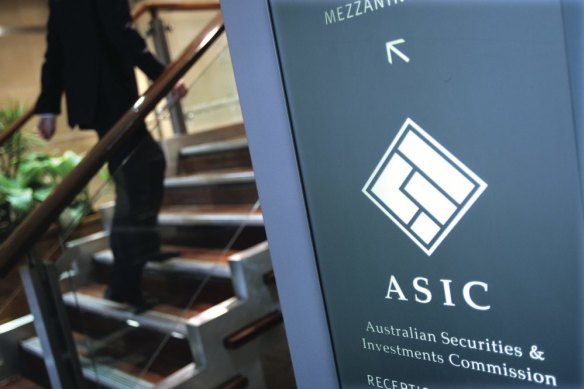Gone in 38 seconds: Regulator using AI to reject serious criminal complaints
The corporate regulator ASIC is using an automated system to dismiss allegations of serious wrongdoing by company directors in as little as 38 seconds, allowing thousands of bosses who oversaw failed firms to escape scrutiny over the past five years.
One report lodged by veteran liquidator Michael Brereton, of firm William Buck, accused the directors of a company that failed while owing creditors up to $250,000 of withholding records, trading while insolvent for more than two years, and breaching their legal duties.

Despite Brereton telling the Australian Securities and Investments Commission (ASIC) that he had documentary evidence to back up his claims, the regulator responded with an auto-generated email sent just 38 seconds later declining to investigate.
New figures from ASIC show that of the more than 30,000 reports from liquidators it received between the 2018 and 2022 financial years, more than 28,000 included allegations that directors had broken the law.
The same data shows that ASIC only referred, on average, less than 3 per cent of those reports to another part of ASIC for more action. The data shows that on average ASIC asked follow-up questions for only around 13 per cent to 18 per cent over the past five years. The remaining 85 per cent of reports received auto-generated responses such as the one Brereton received despite the reports of lawbreaking by directors.
Last financial year, when the volume of reports was still much lower than normal due to protections for struggling companies brought in because of the pandemic, ASIC received 4313 reports from liquidators, with 3767 alleging that people connected to the company were suspected of committing a legal offence. It asked for more information on 593 of those and referred just 65 to its teams for further action. That is a rate of 1.7 per cent of the reports that reported misconduct.
ASIC’s approach, which was unearthed in submissions and testimony to the Parliamentary Joint Committee on Corporations and Financial Services, has infuriated liquidators, who can spend thousands of hours combing over a company’s records and investigating wrongdoing.
“It’s like going to the police and saying ‘I know somebody just robbed the store next door’ and police saying ‘That’s nice’ and doing nothing,” said John Winter, chief executive of the Australian Restructuring Insolvency and Turnaround Association (ARITA), the liquidators’ trade association. “That’s what we’re seeing.”
Brereton is president of ARITA and the names in his report to ASIC submitted to the parliamentary inquiry were redacted.
Australia’s corporate history is littered with examples of company directors acting in a way that is illegal and impacts other creditors, such as the cases of corporate titans Alan Bond and Christopher Skase. But there are also many examples where allegations have been made and no action is taken by the regulator.
Liquidators must report to ASIC if they believe that a director or adviser involved in a failed company has breached the law, regardless of whether the failed firm has enough assets to cover the cost of their time.
The same reports must also be made if the company’s unsecured creditors will get back less than 50¢ in the dollar via an online form, which one ASIC staffer likened to a “tick-a-box” process.
The regulator defended its use of AI to assess reports from liquidators reporting statutory offences by directors.
“Because of the high volume of information provided to us, it is necessary for ASIC to use digital tools in addition to manual methods to prioritise reports,” a spokesman for ASIC said.
“Not every report from a registered liquidator alleging misconduct will rise to the threshold required for ASIC to undertake a full investigation. We are aware of the cost and time it takes for registered liquidators to produce supplementary reports for us to consider further. ASIC has to be strategic in the matters it chooses to pursue so that it can most efficiently use its resources to the maximum effect.”
In the past two and a half years, ASIC has banned 115 individuals from managing corporations after investigations triggered by liquidator reports.
But Winter, the liquidators’ representative, said that was inadequate. “ASIC needs to take seriously these reports of malfeasance,” he said. “Saying they’re not properly funded doesn’t cut it, it’s a cop-out.”
Labor Senator Deborah O’Neill, who chairs the committee’s inquiry into insolvency and questioned ASIC over its practices at the hearing, said it was vital for the regulator to work properly to protect small businesses and give investors confidence in the economy.
“Is it working in the best interest of Australians? Is it structured in the best possible way to give the best outcomes? Is the funding model working? Are the current and prevailing practices fit for purpose for 2023?”
The Business Briefing newsletter delivers major stories, exclusive coverage and expert opinion. Sign up to get it every weekday morning.
Most Viewed in Business
Source: Thanks smh.com